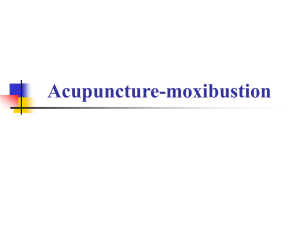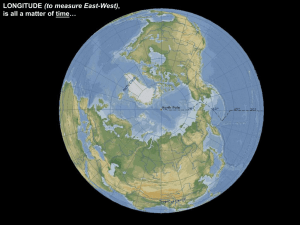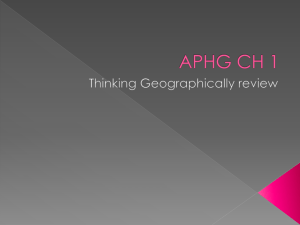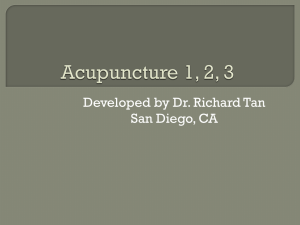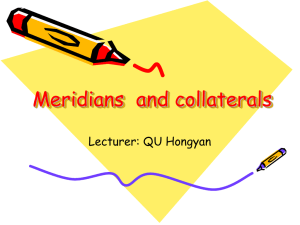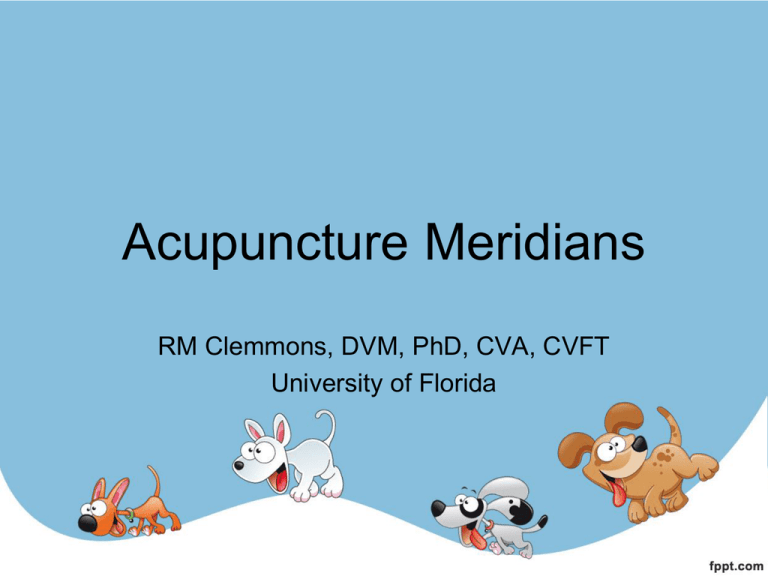
Acupuncture Meridians
RM Clemmons, DVM, PhD, CVA, CVFT
University of Florida
Acupuncture and Meridians
“Meridians not only feed vital energies
to their related organs, they also reflect
any pathological disturbance in those
organs, thus providing a convenient
and highly accurate tool for diagnosis
as well as therapy.”
Concepts of Meridians &
Acupoints
• No one knows how meridians were originally
identified.
• Some believe that acupoints originated by
practitioners treating tender spots, also called
trigger points, using acupressure or acupuncture.
• The radicular pattern of pain during stimulation of
the tender spot may have been interpreted as a
meridian.
• Early practitioners may have believed pain
represented blockage of Qi through a meridian.
• Needling or pressure to reduce pain was then
thought to restore the normal flow of Qi through
the meridian.
An Ancient View of Pain
• Qi travels through our meridian system
• Qi provides nourishment for every cell,
tissue, muscle, gland and organ
• When Qi becomes blocked and
imbalanced, pain and disease result
• As water flows through river networks
nourishing our planet, Qi flows through
our meridian networks nourishing our
body
Acupuncture Background
• Meridian channels (n=12) – run length of
body
• Form the basis for theory and clinical
application of acupuncture
• Part of traditional Chinese medicine
– Used for >3,000 yrs
– Empirical basis
– Rare in U.S. until Nixon visited China in 1972
Flow of Qi
Stagnation = Pain
Acupuncture and Back Pain
Meridians
are
the river
network
inside
Water
flows in
rivers,
Qi flows
in meridians
Meridians: Myth or Reality?
• Close correlation between
– AP Meridian
– Peripheral Nerve Pathways
• Meridians appear to possess bioelectric
function similar to PN
• Meridians follow PN
– Lung (LU) = Musculocutaneous N
– Pericardium (PC) = Median N
8
Meridian Research
• Stimulation of AP
points on meridian
lower resistance at
other meridian
points
• Radio signals places
over one AP point can
be picked up at other
AP points along the
meridian
• Injection of radioisotopes into one
point gradually
accumulates at
other points
9
Nuclear Medicine to Identify
Meridians
• Technetium 99-m injected into acupoints
• Migration studied with scintillation camera
Injection at non-acupoint
No migration 307 sec after
injection
Injection at acupoint
Migration 6 cm/minute
Local Effects: De Qi
PRABM response in horses (pilomotor
reaction along bladder meridian)
11
12 Regular Channels
Chanel Location
Fang Fu Organ
Abbreviation
Tai Yin of the thoracic limb
Lung
LU
Tai Yin of the pelvic limb
Spleen
SP
Shao Yin of the thoracic limb
Heart
HT
Shao Yin of the pelvic limb
Kidney
KID
Jue Yin of the thoracic limb
Pericardium
PC
Jue Yin of the pelvic limb
Liver
LIV
Yang Ming of the thoracic limb
Large Intestine
LI
Yang Ming of the pelvic limb
Stomach
ST
Tai Yang of the thoracic limb
Small Intestine
SI
Tai Yang of the pelvic limb
Urinary Bladder
BL
Shao Yang of the thoracic limb
Triple Heater
TH
Shao Yang of the pelvic limb
Gall Bladder
GB
Energy Levels of 12 Channels
Limbs
Three
Yang
Thoracic
Fu
Organs
LI
Zang
Organs
Three
Yin
LU
Yangming
Limbs
Thoracic
Taiyin
Pelvic
ST
SP
Pelvic
Thoracic
SI
HT
Thoracic
Taiyang
Shaoyin
Pelvic
BL
KID
Pelvic
Thoracic
TH
PC
Thoracic
Shaoyang
Pelvic
Jueyin
GB
LIV
Pelvic
8 Extraordinary Channels
Channel Name
Location
Meridian
Connection
Point
Connections
Du
Governing Vessel
Dorsal Midline
CV, ST
GV1 to GV28
Ren
Conception Vessel
Ventral Midline
GV, ST
CV1 to CV24
Chong
Penetrating
Parallel to KID Meridian
KID
Internal sex organs
to lips via ST30 &
KID Channel
Dai
Girdle
Encircling Lumbar Area
GB
Hypochondriac
region to GV3 via
GB26-28
Yang-Qiao
Yang Mobility
Lateral Hindlimb,
Shoulder & Head
SI, BL, LI, ST,
GB
BL62 to GB20 via
BL1
Yin-Qiao
Yin Mobility
Medial Hindlimb to Eye
KID, SI
KID6 to BL1
Yang-Wei
Yang Linking
Lateral Stifle to
Shoulder
GV, SI, BL, TH,
GB, ST
GB63 to GV15
Yin-Wei
Yin Linking
Medial Hindlimb to
Neck
CV, GB, SP, LIV
KiID9 to CV23 via
LIV14
TCM 24 Hour Clock
LIV 1-3 AM
LU 3-5 AM
LI 5-7 AM
GB 11-1AM
TH 9-11 PM
ST 7-9 AM
SP 9-11 AM
PC 7-9 PM
HT 11-1 PM
KID 5-7 PM
BL 3-5 PM
SI 1-3 PM
Lung Meridian
• Contains 11 points
– Begins in front of
shoulder
– Runs on medial side of
leading edge of front
leg
– Ends at medial nail
bed of first (functional)
digit
• Man/Cats P3 of digit 1
• Dogs P3 of digit 2
• Tai Yin
Large Intestine Meridian
• Contains 20 points
– Begins at medial nail bed
of 2nd functional digit of
foreleg
• Man/Cats P3 of digit 2
• Dogs P3 of digit 3
– Travels on the lateral
aspect of the leading edge
of the leg
– Crosses at GV26 to end 1
fen from widest portion of
the nares
• Yang Ming
Canine LU/LI Meridians
Stomach Meridian
• Contains 45 points
– Begins in center of the orbit
– Forms big smile & then
travels in front of body
(ventral surface of animals)
& lateral side of the front of
rear leg
– Ends on the lateral nail bed
of 2nd function toe
• Man/Cats P3 of digit 2
• Dogs P3 of digit 3
• Yang Ming
Spleen Meridian
• Contains 21 points
– Begins on the medial
surface of 1st functional toe
• Man P3 of digit 1
• Dogs/Cats P3 of digit 2
– Travels up medial side of
the front of the rear leg and
ventrolateral trunk to axial
– Ends in the 7th intercostal
space level with shoulder
• Tai Yin
Canine ST/SP Meridians
Heart Meridian
• Contains 9 points
– Begins in center of
axilla
– Travels on medial
aspect of the caudal
part of the foreleg
– Ends at the nail bed
on the medial side of
digit 5
• Shao Yin
Small Intestine Meridian
• Contains 19 points
– Begins at the nail bed
of the lateral side of
the 5th digit
– Travels up the lateral
aspect of the caudal
foreleg & neck
– Ends at the end of the
tragus of the ear
• Tai Yang
Canine HT/SI Meridians
Bladder Meridian
• Contains 67 points
– Begins 1 fen lateromedial
to the medial canthus of
eye
– Travels down the back
(dorsal surface of animals)
1.5 to 3 cun off midline
• Inner meridian 1.5 cun
• Outer meridian 3.0 cun
– Ends at lateral nail bed of
5th digit of rear leg
• Tai Yang
Kidney Meridian
• Contains 27 points
– Begins at the functional
center of rear foot between
metatarsal/phalangeal joint
• Man between digit 2 & 3
• Dogs/Cats between digit 3
&4
– Travels up caudolateral
aspect of rear leg & near
midline of ventral truck
– Ends in pectoral muscles
• Shao Yin
Canine BL/KID Meridians
Pericardial Meridian
• Contains 9 points
– Begins just lateral to
the cranial nipple
– Travels down the
center of the medial
fore leg
– Ends at center of
middle finger
• Man/Cats tip of 3rd digit
• Dogs medial nail bed of
4th digit.
• Jue Yin
Triple Heater Meridian
• Contains 23 points
– Begins on the lateral
nail bed of the 4th digit
– Travels up the middle
of the lateral aspect of
the fore leg & neck
– Loops around ear and
ends at the orbit where
the eyebrow ends (if
the eyebrow is
extended like in man)
• Shao Yang
Canine PC/TH Meridians
Gall Bladder Meridian
• Contains 44 points
– Start 2 fen
ventrolateral to lateral
canthus
– Travels down the
medial part of the
lateral trunk & leg
– Ends at lateral nail bed
of the 4th digit
• Shao Yang
Liver Meridian
• Contains 14 points
– Begins on lateral nail
bed of the 1st functional
toe
• Man at 1st digit
• Dog/Cats at 2nd digit
– Travels up the middle
of the medial leg and
trunk
– Ends at 6th
costrochondral junction
• Jue Yin
Canine GB/LIV Meridians
Governing Vessel Meridian
• Contains 28 points
– Begins between anus
and tail
– Travels up the dorsal
midline
– Ends under lip at gum
line
• Yang
Conception Vessel Meridian
• Contains 24 points
– Begins between the
anus and the external
genitailia
– Travels up the ventral
midline
– Ends in center of
metolabial groove
• Yin
Canine GV/CV Meridians
Multiple Meridians
Multiple Meridians
Conclusion
• Meridians make up
the highways for
organized energy
circulation throughout
the body.
• Acupuncture points
are the major cities
along the highway
which control traffic.
• Knowing the location
and timing of the
energy flow in the
body helps develop
appropriate treatment
strategies.
• Remember, that the
surface meridian also
connects with the
central one.

